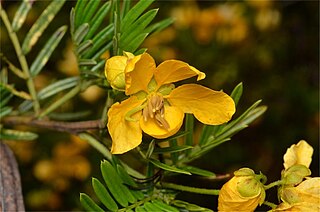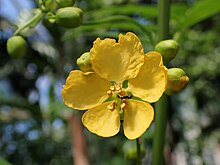
Robert Sweet was an English botanist, horticulturist and ornithologist.

Senna, the sennas, is a large genus of flowering plants in the legume family. This diverse genus is native throughout the tropics, with a small number of species in temperate regions. The number of species is estimated to be from about 260 to 350. The type species for the genus is Senna alexandrina. About 50 species of Senna are known in cultivation.

Senna covesii is a perennial subshrub in the family Fabaceae, native to the Mojave Desert and Sonoran Desert in southeastern California, southern Nevada, and Arizona in the United States, and northern Baja California in Mexico. It is found on desert plains and in sandy washes between 500 and 600 m above sea level, and is very common in Joshua Tree National Park. The specific epithet honors ornithologist Elliott Coues.

Maurandya barclayana, commonly called angels trumpet or Mexican viper, is an ornamental plant in the family Plantaginaceae native to Mexico.

Senna artemisioides, commonly known as silver cassia, is a species of flowering plant in the family Fabaceae and is endemic to Australia, where it is found in all mainland states and territories. It is a small, woody shrub with silver-green leaves and yellow flowers.

Boronia pinnata is a plant in the citrus family, Rutaceae, and is endemic to New South Wales. It is an erect, woody shrub with pinnate leaves and groups of between three and forty pink flowers arranged in leaf axils. It flowers in spring and early summer and is found in coastal areas between Ballina and Jervis Bay.

Boronia muelleri, commonly known as the forest boronia or pink boronia, is a flowering plant that occurs in forest, woodland and heath in Victoria and New South Wales in Australia. It is an erect, woody shrub or small tree with pinnate leaves and up to fifteen pink to white four-petalled flowers arranged in leaf axils in spring and summer.

Sambucus australasica, commonly known as yellow elderberry, native elderberry or native elder, is a species of flowering plant in the family Adoxaceae and is endemic to eastern Australia. It is a shrub or small tree with pinnate leaves that have coarse teeth on their edges, small white flowers with three petals, and yellow fruit. It is usually found in and on the edges of rainforest.

Senna italica, the Port Royal senna, Italian senna, or Senegal senna is a legume tree in the genus Senna. It is recognized by many other common names based on the regions it grows in. In India, it is used to produce a powder for treating hair-related diseases which is known as “neutral henna”. Whereas, in some parts of the world, this species is cultivated for the leaves which yield the drug senna, known commonly as Senna glycoside, which in turn is the base for a laxative. Senegal senna is easily distinguishable through its many distinctive features. There are 3 subspecies of this plant based on the size of the inflorescence and the length of the petiole. The subspecies are italica, micrantha, and arachoides. In many regions, this plant is cultivated commercially and medicinally.

Teucrium corymbosum, commonly known as forest germander, is a species of flowering plant in the family Lamiaceae and is native to Australia and New Guinea. It is a perennial herb or subshrub densely covered with glands and with narrow egg-shaped leaves usually with toothed edges, and groups of mostly up to ten white flowers.

Senna acclinis, commonly known as rainforest cassia or brush senna, is a species of flowering plant in the family Fabaceae and is endemic to near-coastal areas of eastern Australia. It is a shrub with pinnate leaves and bright golden yellow flowers in groups of two to five and long, narrow seed pods. It is similar to other species of Senna that are environmental weeds.

Pandorea baileyana, commonly known as large-leaved wonga vine, is a species of flowering plant in the family Bignoniaceae and is endemic to eastern Australia. It is a woody climber with pinnate leaves that have seven to nine egg-shaped leaflets, and relatively small cream-coloured flowers that are pink inside.

Agrimonia pubescens, the soft agrimony or downy agrimony, is a flowering plant in the genus Agrimonia, a member of the rose family. It grows in dry areas and woodlands.

Boronia filifolia, commonly known as the slender boronia, is a plant in the citrus family Rutaceae and is endemic to south-eastern Australia. It is a slender shrub with simple or pinnate leaves and pale to deep pink four-petalled flowers.

Pimelea curviflora, also known as curved rice-flower, is a shrub in the family Thymelaeaceae and is endemic to Australia. It is a small, hairy shrub with greenish-yellow or red tubular flowers.

Senna pendula, also known as Easter Cassia, Christmas Senna, winter Senna, climbing Cassia, golden shower, pendant Senna and valamuerto, is a plant of the Fabaceae family with a shrub habit that is native to South America. It used in various parts of the world as an ornamental plant and is an environmental weed in Australia. The flowers are yellow and the name pendula means 'pendulous' or 'drooping'.
Goodenia valdentata, commonly known as Davenport Range goodenia, is a species of flowering plant in the family Goodeniaceae and is endemic to a restricted area of South Australia. It is a subshrub with erect branches, coarsely-toothed, egg-shaped leaves and bright yellow flowers usually arranged singly in upper leaf axils.

Austrocallerya australis, commonly known as native wisteria, blunt wisteria or Samson's sinew in Australia, is a species of flowering plant in the family Fabaceae, native to north-eastern Australia, New Guinea and some Pacific Islands. It is a tall, woody climber with pinnate leaves, the leaflets oblong, elliptic or egg-shaped, and panicles of purple, pea-like flowers.

Senna aciphylla, commonly known as sprawling senna or Australian senna, is a species of flowering plant in the family Fabaceae and is endemic to eastern Australia. It is a sprawling shrub with pinnate leaves with eight to twelve pairs of linear to narrowly elliptic leaflets, and yellow flowers in pairs or groups of three.

Senna barronfieldii, commonly known as southern cassia, is a species of flowering plant in the family Fabaceae and is endemic to eastern Australia. It is an erect shrub with more or less glabrous, pinnate leaves with eight to thirteen pairs of lance-shaped or elliptic leaflets, and yellow flowers in groups of three to five.




















